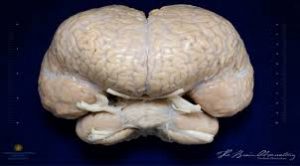
[ms_audio style=”light” mp3=”https://www.dolphincommunicationproject.org/wp-content/uploads/2022/05/TheDolphinPod-2006-09-20-54132.mp3″ ogg=”” wav=”” mute=”” loop=”” controls=”yes” class=”dcp-embed-mp3″ id=””]
In the dolphin brain, breathing is controlled consciously – that means that a dolphin has to think about every breath it wants to take before it takes it. Learn how dolphins sleep, and still manage to control their breathing.
Your breathing is controlled by parts of your brain called the medulla oblongata and the pons – they are located deep in your brain-stem down at the base of your brain. These little guys are in control of a lot of very important things that you do, including keeping your heart beating. And, you have them to thank every time you sneeze, swallow or blink – they control it all! Every second of every hour of every day the medulla oblongata and the pons are working hard to make sure that your body keeps trucking along.
They never sleep – even when other parts of your brain do. We can, of course, take over conscious control of our own breathing – try it by holding your breath while you listen to this podcast. You have just relieved the medulla oblongata and the pons of their breathing duties. But, they are poised and ready to resume control of your breathing whenever you decide need them to. Isn’t it nice to know that they will always be there for you? Here’s an unsettling fact: for dolphins, the medulla oblongata and the pons do NOT control their breathing. Ever! In the dolphin brain, breathing is controlled consciously – that means that a dolphin has to think about every breath it wants to take before it takes it. This makes a lot of sense really – since dolphins spend their entire lives underwater, they need to think about and time exactly when they go up for air, so there is no real need for an involuntary breathing mechanism. But, that raises the following question: if a dolphin has to be awake and thinking about every breath it takes, how on earth do they sleep? A major flaw with this conscious breathing system is that if a dolphin ever really did fall asleep, it would simply stop breathing and die. The solution: never fall asleep! Or, at least in the case of dolphins, never sleep both halves of your brain at the same time. Dolphins, just like humans, have brains divided into two halves or ‘hemispheres‘. Over the years, they have evolved a neat little trick where they can put one half of their brain to sleep while the other half stays awake. The awake-half will then be able to control breathing and swimming, and other behaviors. For humans and dolphins, each eye is wired to the brain on the opposite side of the head. So the left eye is controlled by the right half of the brain and vice versa. When dolphins are resting, they sometimes close one eye – if you see a resting dolphin with her left eye closed, you can assume that the right side of her brain is asleep. But, the left half of her brain will be awake; controlling her breathing and making sure she doesn’t suffocate or drown. And, quite literally, keeping one eye out for sharks. When dolphins rest, they usually swim quite slowly not too far from the surface, making it easier to swim up for a breath. Each brain half will get a chance to rest for a while before swapping with the other half. Generally, dolphins will rest like this for about 8 hours a day. Luckily for dolphins, the medulla oblongata and the pons are still in control of their heartbeat. Imagine how tiring it would be if you had to think about making your heart beat all day long. Some yoga masters claim to be able to control their heartbeat, but as for me – well, I am glad I am neither a dolphin nor a yoga master; I am happy to let the medulla oblongata and the pons run the whole show when I am asleep. Thanks guys! I’m also pretty happy I don’t have to worry about sharks nibbling on me when I decided to take a nap
